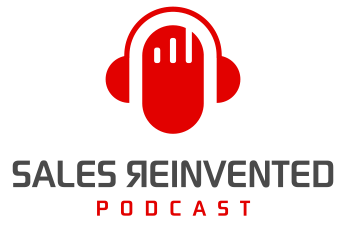Episode 248: Victor Antonio

Meet
Victor Antonio
Victor Antonio earned a B.S. in Electrical Engineering and then an MBA, leading him to build a 20 year career as a top sales executive and becoming President of Global Sales and Marketing for a $420 million company. As Vice President of International Sales in a Fortune 500 $3B corporation at the time, he was selected from over 500 sales managers to join the President’s Advisory Council for excellence in sales and management. Victor is an expert on giving talks about sales and has written many books on sales tactics and motivation. He recently published his new book, “Sales Ex Machina: How Artificial Intelligence is Changing the World of Selling.”
Our Mission Is To Change The Negative Perception Of Sales People
Our Vision Is A World Where Selling Is A Profession To Be Proud Of
In today’s episode of Sales Reinvented, we do a special episode exchange with the Outside Sales Podcast. Steve Benson interviews legendary sales author Victor Antonio. They discuss the importance of the sales presentation process and how to get in front of any objection. Victor talks about the “Hero Story” process and how to gain the confidence of your prospect. This episode is packed with useful information that will help you master your sales presentations. Don’t miss it!
Outline of This Episode
- [1:22] More about Victor Antonio
- [2:22] Why you need a presentation process
- [7:16] How to properly uncover objections
- [11:58] The structure of a great presentation
- [15:23] The structure of the hero story
- [21:15] How to sell a similar product
- [23:37] How to show a prospect social proof
- [28:41] How to move toward the ask
- [31:06] Learn to pivot on the fly
- [33:26] Steve’s “Sales in 60 seconds” segment
- [35:46] The best way to practice presentations
- [38:18] The first step to master sales presentations
- [46:28] How to connect with Victor Antonio
Why you need a presentation process
Victor points out that everyone has a sales process. But somewhere in that process, you have to give a presentation. Most people don’t talk about the fact that there is a process to that presentation. He needs to answer these two questions first:
- Who is your audience going to be?
- What are their pain points?
Before Victor does a keynote or a presentation, he asks his customers to let him talk to salespeople to see what they’re struggling with. They give him the blueprint for what he says from the stage. It’s also important to use their language when he talks to them about their pain.
Victor likes to use the iceberg analogy. You can only see 10% of an iceberg, the other 90% is underwater. Most salespeople talk about features, benefits, and advantages. Customers focus on quality, service, and price. Most salespeople don’t look at the unstated or latent needs.
If you understand what’s holding a customer back from a buying decision, you can sell more effectively when you present. You need to find the 90% of issues below the iceberg and address them. Listen to hear Victor and Steve walk through a hypothetical scenario to drive the point home.
How to properly uncover objections
Victor recommends getting all of your salespeople together and asking: “What is holding back our customers from buying?” Remove features, benefits, advantages, quality, service, and price from the equation. What’s left? You’ll end up with a laundry list of things holding them back. Which ones come up the most commonly? You can figure out what the latent needs are.
You can then bring these concerns up in a sales presentation proactively before they even come up as an objection. Victor will go into a sales presentation and raise the objection himself. Why? Because when you raise the objection, you control the objection and how you can dispose of it. If the customer brings it up, you’re defending yourself—and less likely to change their mind.
The structure of a great presentation
Victor folds a sheet of paper in half four separate times. Once he unfolds it, he’s left with 16 squares. That is how you begin your presentation layout. Each box represents a slide. He chooses what he wants to start with at the beginning to make an impact. By the 3rd or 4th slide, he’s introducing the first objection. If you continue to interlace common objections into your presentation, you’ll feel the resistance lessen.
He notes that the biggest mistake outside salespeople make is that they go in and share who they are, what the agenda is, and background about the company. Then they talk about their mission statement and other businesses they’ve worked with. They’ve spent the first 5–10 minutes talking about themselves. The customers don’t care. Those minutes are the most valuable time you have most—most people waste it.
Instead, start by demonstrating that you understand their pain. Spend the 5–10 minutes on them and they’ll be ready to listen to you. How does he work the product and conclusion in using the hero story method? Listen to hear what his structure looks like.
How to move toward the ask
You have to guide toward your close. It begins once you present your solution. You’re blocking objections and reducing resistance. As you show something, you look for confirmation. You’re conversing with them. Share how you do things and share insight—information beyond the obvious. When you get “huh” or “I didn’t know that” types of responses, you know you’re doing well in your presentation.
When you get to the end, it’s a natural ask: “We’ve gone through all of these features. Is there any reason we couldn’t start a demo next week to see how this works? You can then look at the data to see if it makes sense.” 63% of salespeople don’t ask for the order or the next stage in the process.
What can you do to pivot on the fly? What’s the best way to practice presentations? How should you practice to master sales presentations? Listen to the whole episode to hear more of Victor’s expert insight!
-
Resources & People Mentioned
- Victor’s Sales Training Courses
-
Connect with Victor Antonio
Connect With Paul Watts
Audio Production and Show notes by
PODCAST FAST TRACK
https://www.podcastfasttrack.com
Share This Episode, Choose Your Platform!
